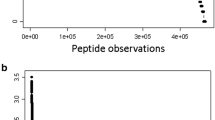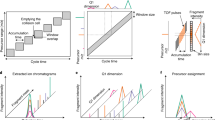Abstract
The aim of this study was to investigate the quality and reproducibility of mass spectra derived from a matrix-assisted laser desorption ionisation time-of-flight mass spectrometry (MALDI-TOF MS) platform in a patient population undergoing carotid endarterectomy. Plasma samples were either digested with trypsin or left undigested, fractionated with either C18 or weak cation exchange (WCX) columns and analysed by MALDI-TOF MS. Quality of mass spectra for each method was assessed by baseline correction (lower area under the curve ratio indicating higher quality) and signal-to-noise ratio. Mean coefficient of variation (CV%) assessed reproducibility between repeated experiments and methods. Identified mass peak intensity differences were assessed for consistency across repeated experiments. Plasma from six patients was analysed. The quality of mass spectra was significantly better when derived from digested plasma fractionated by either WCX or C18 methods compared to undigested plasma fractionated by WCX (analysis of variance, p < 0.05). Mean CV% for repeated experiments was 18% and 28% for WCX and C18 fractionated digested plasma, respectively. A small number of differences in mass peak intensities were consistently observed in repeated experiments. Repeated experiments are required to confidently identify non-random mass peak intensity differences as putative plasma biomarkers that merit further investigation.




Similar content being viewed by others
Abbreviations
- MALDI-TOF:
-
Matrix-assisted laser desorption time-of-flight
- WCX:
-
Weak cation exchange
- S/N:
-
Signal to noise
- AUCR:
-
Area under the curve ratio
- eGFR:
-
Estimated glomerular filtration rate
References
Apweiler R, Aslanidis C, Deufel T, Gerstner A, Hansen J, Hochstrasser, et al. Approaching clinical proteomics: current state and future fields of application in fluid proteomics Clinical. Chem Lab Med. 2009;47:724–44.
Feng X, Liu X, Luo Q, Liu B-F. Mass spectrometry in systems biology: an overview. Mass Spectrom Rev. 2008;27:635–60.
McLerran D, Grizzle WE, Feng Z, Thompson IM, Bigbee WL, Cazares LH, et al. SELDI-TOF whole serum proteomic profiling with IMAC surface does not reliably detect prostate cancer. Clin Chem. 2008;54:53–60.
Hortin GL, Carr SA, Anderson NL. Advances in protein analysis for the clinical laboratory. Clin Chem. 2010;56:149–51.
Semmes OJ, Feng Z, Adam B-L, Banez LL, Bigbee WL, Campos D, et al. Evaluation of serum profiling by surface enhanced laser desorption/ionization time-of-flight mass spectrometry for detection of prostate cancer: assessment of platform reproducibility. Clin Chem. 2005;51:102–12.
Whitely W, Chong WL, Sengupta A, Sandercock P. Blood markers for the prognosis of ischaemic stroke. Stroke. 2009;40:e380–9.
Karas M, Hillenkamp F. Laser desorption ionization of proteins with molecular masses exceeding 10,000 Daltons. Anal Chem. 1988;60:2299–301.
Tanaka K, Waki H, Ido Y, Akita S, Yoshida Y, Matsuo T. Protein and polymer analyses up to m/z 100,000 by laser ionization time-of-flight mass spectrometry. Rapid Commun Mass Spectrom. 1988;2:151–3.
Hortin GL. The MALDI-TOF mass spectrometric view of the plasma proteome and peptidome. Clin Chem. 2006;52:1223–37.
Albrethsen J. Reproducibility in protein profiling by MALDI-TOF mass spectrometry. Clin Chem. 2007;53:852–8.
Mercier C, Truntzer C, Pecqueur D, Gimeno J-P, Belz G, Roy P. Mixed-model of ANOVA for measurement reproducibility in proteomics. J Proteomics. 2009;72:974–81.
Jin G, Zhou X, WH WS. The challenges in blood proteomic biomarker discovery. In: Pham T, editor. Computational biology, Applied bioinformatics and biostatistics in cancer research, vol. 2. Heidelberg: Springer; 2009. p. 273–99.
Ransohoff D. Proteomics research to discover markers: what can we learn from Netflix®? Clin Chem. 2010;56:172–6.
Ransohoff DF. Rules of evidence for cancer molecular marker discovery and validation. Nat Rev Cancer. 2004;4:309–14.
Kramer HB, Lavender KJ, Qin L, Stacey AR, Liu MKP, di Gleria K, et al. Elevation of intact and proteolytic fragments of acute phase proteins constitutes the earliest systemic antiviral response in HIV-1 infection. PLoS Pathog. 2010;6(5):e1000893.
Whitely W, Tseng M-C, Sandercock P. Blood biomarkers in the diagnosis of ischaemic stroke: a systematic review. Stroke. 2008;39:2902–9.
Zhang X, Leung S-M, Morris C, Shigenaga M. Evaluation of a novel, integrated approach using functionalized magnetic beads, bench-top MALDI-TOF-MS with prestructured sample supports, and pattern recognition software for profiling potential biomarkers in human plasma. J Biomol Tech. 2004;15:167–75.
Anderson NL, Anderson NG. The human plasma proteome. Mol Cell Proteomics. 2002;1(11):845–67.
Stahl B, Steup M, Karas M, Hillenkamp F. Analysis of neutral oligosaccharides by matrix assisted laser desorption/ionization mass spectrometry. Anal Chem. 1991;63:1463–6.
Harvey DJ. Quantitative aspects of matrix assisted laser desorption mass spectrometry of complex oligosaccharides. Rapid Commun Mass Spectrom. 1993;7:614–9.
Cohen SL, Chait BT. Influence of matrix solution conditions on the MALDI-MS analysis of peptides and proteins. Anal Chem. 1996;68:31–7.
Francisco ML, Amado DP, Graca Santana-Marques M, Ferrer-Correia AJ, Tomer KB. Discrimination effects and sensitivity variations in matrix assisted laser desorption/ionization. Rapid Commun Mass Spectrom. 1997;11:1347–52.
Malyarenko DI, Cooke WE, Adam BL, Malik G, Chen H, Tracy ER, et al. Enhancement of sensitivity and resolution of surface enhanced laser desorption/ionization time-of-flight mass spectrometric records for serum peptides using time-series analysis techniques. Clin Chem. 2005;51:65–74.
Baggerly KA, Morris JS, Wang J, Gold D, Xiao L-C, Coombes KR. A comprehensive approach to the analysis of matrix-assisted laser desorption/ionization-time of flight proteomics spectra from serum samples. Proteomics. 2003;3:1667–72.
Nimptsch A, Schibur S, Schnabelrauch M, Fuchs B, Huster D, Schiller J. Characterization of quantitative relationship between signal to noise (S/N) ratio and sample amount on target by MALDI-TOF MS: determination of chondroitin sulfate subsequent to enzymatic digestion. Anal Chim Acta. 2009;635:175–82.
Wardlaw JM, Murray V, Berge E, Del Zoppo GJ. Thrombolysis for acute stroke. Cochrane Database Syst Rev. 2009;4:CD000213.
Saenger AK, Christenson RH. Stroke biomarkers: progress and challenges for diagnosis, prognosis, differentiation, and treatment. Clin Chem. 2010;56:21–33.
Acknowledgements
This study was funded by the NIHR Biomedical Research Centre Oxford, UK.
Author information
Authors and Affiliations
Corresponding author
Additional information
Ediri Sideso and Michalis Papadakis contributed equally to this work.
Rights and permissions
About this article
Cite this article
Sideso, E., Papadakis, M., Wright, C. et al. Assessing the Quality and Reproducibility of a Proteomic Platform for Clinical Stroke Biomarker Discovery. Transl. Stroke Res. 1, 304–314 (2010). https://doi.org/10.1007/s12975-010-0036-2
Received:
Revised:
Accepted:
Published:
Issue Date:
DOI: https://doi.org/10.1007/s12975-010-0036-2




